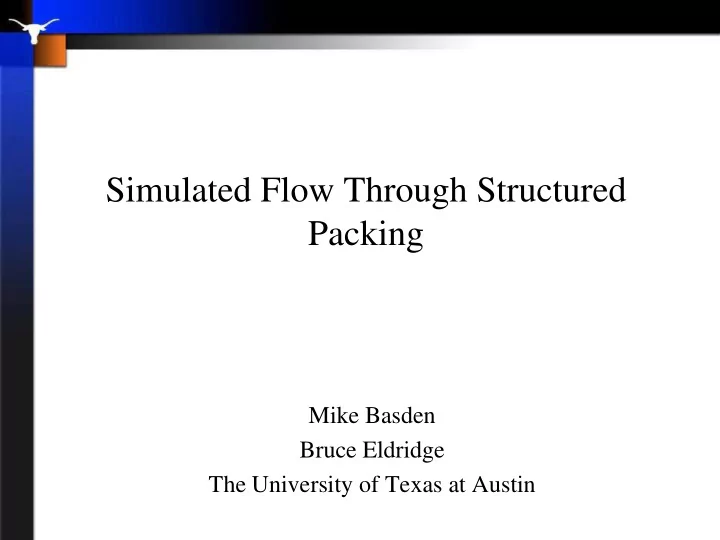

Simulated Flow Through Structured Packing Mike Basden Bruce Eldridge The University of Texas at Austin
Structured Packing • Used in distillation, absorption, and stripping • High efficiency, low pressure drop, and high capacity
Single Phase Simulations • Experimental Validation – Simulation and experimental bed were nearly identical
Comparison to Experimental Data 180 EXP = 23.944*F 1.7464 Total Bed Pressure Drop (Pa) 160 k- ω = 20.118*F 1.7307 140 k- ε = 20.74*F 1.7537 120 k- ε 100 k- ω 80 EXP 60 40 20 0 0 0.5 1 1.5 2 2.5 3 3.5 F-factor (Pa 0.5 ) F = v g ρ g
Packing Design Simulations
Packing Dimensions θ h b
α = 45°, a p = 250 m 2 /m 3 , U GS = 1 m/s, Nitrogen Flow
Multiphase Simulations • Effect of simulation contact angle, liquid density, surface tension, and liquid viscosity examined on periodic geometry
Contact Angle Definition Starov, V. M.; Velarde, M. G.; Radke, C. J. Wetting and Spreading Dynamics; CRC Press: Boca Raton, 2007.
Contact Angle = 75° h L = 6.5% 0.074 N/m 0.037 N/m 0.018 N/m a f = 0.27 a f = 0.30 a f = 0.35 L= 39 GPM/ft 2 L= 46 GPM/ft 2 L= 47 GPM/ft 2
Contact Angle = 30° h L = 6.0% 0.018 N/m 0.074 N/m 0.037 N/m a f = 0.80 a f = 0.48 a f = 0.65 L= 21 GPM/ft 2 L= 22 GPM/ft 2 L= 20 GPM/ft 2
Contact Angle = 0° h L = 6.5% 0.074 N/m 0.037 N/m 0.018 N/m a f = 0.80 a f = 0.97 a f = 0.98 L= 19 GPM/ft 2 L= 19 GPM/ft 2 L= 23 GPM/ft 2
Impact of Liquid Density θ c =30°, h L = 6.5%, σ = 0.074 N/m a f = 0.281 a f = 0.48 a f = 0.58 L= 24 GPM/ft 2 L= 23 GPM/ft 2 L= 23 GPM/ft 2 ρ= 500 kg/m 3 ρ= 997 kg/m 3 ρ= 1500 kg/m 3
Impact of Viscosity θ c =30°, σ = 0.018 N/m, ρ =997.561 kg/m 3 μ L =0.01774 Pa-s μ L =0.0008871 Pa-s h L =6.7% h L =5.9% a f = 0.68 a f = 0.80 L= 2.4 GPM/ft 2 L= 20.9 GPM/ft 2
Experimental Validation • Wetted area measurements performed via absorption of CO 2 into dilute caustic solution • 10 ft. bed of Mellapak N250.Y
Wetted Area – Experimental Measurements m 3 /m 2 -hr 0 20 40 60 80 0.61 Pa 0.5 20 ACFM 1.2 1.22 Pa 0.5 40 ACFM Start of Run 1 1.83 Pa 0.5 60 ACFM Fractional Wetted Area Tsai Correlation 0.8 0.6 0.4 0.2 0 0 10 20 30 Liquid Load (GPM/ft 2 )
Multiphase Simulations – CT Geometry Pressure Boundary • Calculate fractional Condition wetted area and holdup for indicated element – a f = a w /a p Liquid – h L Velocity – ΔP Irrigated Inlet
X-ray CT / CFD Comparison 0.074 N/m 0.074 N/m a f = 0.85 a f = 0.89 L = 15 GPM/ft 2 L = 15 GPM/ft 2 C. W. Green, J. Farone, J. K. Briley, R. B. Eldridge, R. A. Ketcham , B. Nightingale, “Novel Application of X -ray Computed Tomography: Determination of Gas/Liquid Contact Area and Liquid Hold- up in Structured Packing,” Ind. Eng. Chem. Res ., (46) pg. 5734-5753, 2007.
L=20 GPM/ft 2 θ c = 0°, a f =0.91 θ c = 30°, a f =0.67
Fractional Wetted Area (m 3 /m 2 -hr) 0 20 40 60 1.2 CFD Sim, θ=0 ° 1.0 Fractional Wetted Area a f = 0.718L 0.080 R² = 0.978 0.8 CFD Sim, θ=30 ° 0.6 a f = 0.323L 0.245 R² = 1 0.4 Tsai Model 0.2 a f = 0.609L 0.1547 R² = 1 0.0 0 5 10 15 20 25 Liquid Load (GPM/ft 2 )
Fractional Liquid Holdup m 3 /m 2 -hr 0 20 40 60 9.0 8.0 7.0 Liquid Holdup (%) 6.0 CFD Sim, θ=30 ° 5.0 CFD Sim, θ=0 ° 4.0 Experimental 3.0 2.0 1.0 0.0 0 5 10 15 20 25 Liquid Load (GPM/ft 2 )
Irrigated Pressure Drop CFD Experimental Contact Liquid Percent F-factor Pressure Pressure Angle Load Error Drop Drop ° GPM/ft 2 Pa 0.5 Pa/m Pa/m 0 10 0.86 74.7 52.0 43.5% 0 15 0.77 74.4 52.1 42.7% 0 20 0.69 73.4 58.8 24.8% 30 10 0.82 73.1 47.6 53.6% 30 15 0.73 71.4 46.7 52.8% 30 20 0.66 73.5 54.1 35.8%
Conclusions • Single phase simulations can predict trends and pressure drops accurately • Multiphase simulations require further analysis – Experimentally determined static contact angle not appropriate for predicting wetting – Liquid holdup and irrigated pressure drop need additional corrections: • Damping of the turbulence at the interface • Viscosity correction
Acknowledgements • CD-adapco • Mark Pilling and Sulzer Chemtech • Texas Advanced Computing Center • UT High Resolution CT Lab • Process Science and Technology Center • Lummus Technology • Christian Waas and Shawn Grush
Questions? • Mike Basden – mbasden@utexas.edu • Bruce Eldridge – eldridge@che.utexas.edu
Recommend
More recommend